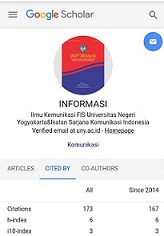RELASI INTERNET DAN MEDIA SOSIAL DALAM PEMBENTUKAN BRAND AWARENESS, IMAGE DAN EXPERIENCE PRODUK ASING
Abstract
The effect of globalization on communication process appears especially in digital media which made communication exchange faster. Cultural process also create homogenization of product choice, when global brand looks more familiar than local brand. Internet and social media give an opportunity for consumer to access the product information and interact with them. Interactivity as part of digital media offers unlimited access and the power of word of mouth in terms of internet and social media. In the end, it will affect the brand awareness, image and attitude about product, especially in Generation Y who are close with media digitalization itself as part of their life.
Kemunculan globalisasi mempengaruhi proses komunikasi terutama dengan adanya media digital yang semakin mempercepat pertukaran informasi. Hal ini kemudian mempengaruhi proses kebudayaan, termasuk diantaranya mendorong homogenisasi dalam pemilihan produk, saat brand global menjadi lebih familiar dibandingkan dengan produk lokal. Internet dan media sosial muncul dan memberikan kesempatan pada konsumen untuk mengakses informasi sekaligus berinteraksi dengan produk. Interaktivitas merupakan sebuah hal baru yang ditawarkan oleh media digital. Internet dengan akses informasi yang tanpa batas dan media sosial dengan kekuatan word of mouth yang mempengaruhi pembentukan kesadaran, persepsi dan pembelian sebuah produk terutama di kalangan Generasi Y yang memiliki kedekatan dengan dunia
digital.
Keywords
Full Text:
PDFReferences
Belk, R.W. 1988. Possessions and the extended self. The Journal of Consumer Research, 15(2), 139-168. Terarsip dalam: http:// www.difi.uniud.it/tl_files/utenti/crisci/ Belk%201988.pdf.
Bray, J. P., 2008. Consumer Behaviour Theory: Approaches and Models. Terarsip dalam: http://eprints.bournemouth. ac.uk/10107/
De Vaus, D.A. 1991. Survey in Social Research (3rd ed.). London: Allen dan Unwin.
Dogerlioglu-Demir, K. dan Tansuhaj, P. 2011. Global vs local brand perceptions among Thais and Turks. Asia Pacific Journal of Marketing and Logistics, 23(5), 667-683. DOI 10.1108/13555851111183084.
Douglas, S.P. dan Craig, C.S. 1997. The changing dinamyc of consumer behaviour: implications for cross- cultural research. International Journal of Research in Marketing, 14, 379-395.
Giddens, A. 1990.The Consequences of Modernity.Cambridge: Polity.
Grazella, M. 2012. Using Viral Power Social Media Marketing. 2012. The Jakarta Post (online). Terarsip dalam: http://www. thejakartapost.com/news/2012/01/24/ using-viral-power-social-media- marketing.html
Gurau, C. 2008. Integrated online marketing communication: implementation and management.JournalofCommunication Management, 12(2), 169-184.
Hamidi, N., Pezeshki, P.M. dan Moradian, A. 2010. Weighting the criteria of brand selecting in beverage industries in Iran. Asian Journal of Management Research, 250-267.
Heding, T., Knudtzen, C.F. dan Bjerre, M. 2009. Brand Management: Research, Theory and Practice. New York: Routledge.
Hybels, S. dan Weaver, R.L. II. 2004. Self, perception, and communication. In Ina Nur Ratriyana, Relasi Internet dan Media Sosial dalam Pembentukan Brand Awareness, Image ...
Communicationg Effectively (7th ed.).Boston: McGraw-Hill.
Len, L. 1997. Generation ‘Y’. Progressive Grocer, 76(3).
MacInnis, D.J., Moorman, C. & Jaworski, B.J. 1991. Enhancing and Measuring Consumers’ Motivation, Opportunity, and Ability to Process Brand Information from Ads. Journal of Marketing, 55(4),32- 53.
Majalah Mix (online). 2014. Mendefinisikan Public Relations Masa Depan. Majalah Mix. Terarsip dalam: http://mix.co.id/ public-relations/mendefinisikan-public- relations-masa-depan/.
McCrindle, M. dan Wolfinger, E. 2010. Generations defined. Ethos, 18(1).
McLuhan, M. and Fiore, Q. 1967.The Medium is the Message: An Inventory of Effects. New York: Bantam.
Miller, K. 2002. Communication Theories: Perspectives, Processes and Contexts. Boston: McGraw-Hill.
Montgomery dan Amstrong. 1970. Brand trial after a credibility change. Journal of Advertising Research,10 (5), 26-32.
Moriarty, S., Mitchell, N. dan Wells, W. 2012. Advertising and IMC: Principles and Practice (9th ed.). New Jersey: Prentice Hall.
Morton, L. 2002. Targeting generation Y. Public Relation Quarterly, 47(2).
Noviandasari, L. 2015. Jumlah pengguna facebook mobile Indonesia tertinggi dunia. Techinasia (online). Terarsip dalam: https://id.techinasia.com/ jumlah-pengguna-facebook-mobile- indonesia-tertinggi-dunia (13 April 2015).
Priyatno, D. 2012.Cara Kilat Belajar Analisis Data dengan SPSS 20. Yogyakarta: Penerbit Andi.
Rantanen, T. 2005. The Media and Globalization. London: Sage Publication.
Robertson, R. 1992. Globalization: Social Theory and Global Culture. London: Sage.
Schmitz, A. 2012. A Primer on Communication Studies. Terarsip dalam: http://2012books.lardbucket.org/ books/a-primer-on-communication- studies/index.html
Seung, A. & Jin, A. 2014. Following Celebrities’ Tweets About Brands: The Impact of Twitter-Based Electronic Word-of- MouthonConsumers’SourceCredibility Perception, Buying Intention, and Social Identification With Celebrities. Journal of Advertising, 43(2), 181–195.
Simmons, G.J. 2007. “i-Branding”: developing the internet as a branding tool. Marketing Intelligence & Planning, 25(6), 544-562.
Simon, H., Li, H., Martin, S.R. & Madden, T.J. 2016. The influence of social media interactions on consumer–brand relationships: A three-country study of brand perceptions and marketing behaviors. International Journal of Research in Marketing, 33, 27–41.
Sue, V.M dan Ritter, L.A. 2012. Conducting Online Surveys. Thousand Oaks, California: Sage Publication.
Sun, M.W. 2011. Consumption of luxury fashion brands: the motives of generation Y consumers in China (Master thesis). Terarsip dalam: http://aut.researchgateway.ac.nz/bitstream/handle/10292/1335/SunM. pdf ?sequence=3
Tellis, Gerard J.JMR. 1988. Advertising Exposure, Loyalty and Brand Purchase. Terarsip dalam: http://www.rcf.usc. edu/~tellis/advertising.pdf.
Uyanto, S. 2006. Pedoman Analisis Data dengan SPSS. Yogyakarta: Graha Ilmu.
Widhiarso, W. 2011. Aplikasi analisis kovarian dalameksperimen.Manuskrip Publikasi. Fakultas Psikologi Universitas Gadjah Mada. Yogyakarta.
DOI: https://doi.org/10.21831/informasi.v46i1.9654
Refbacks
- There are currently no refbacks.
Copyright (c) 2016 Ina Nur Ratriyana
Supervised by
Our Journal has been Indexed by:
Informasi by http://journal.uny.ac.id/index.php/informasi is licensed under a Creative Commons Attribution-NonCommercial 4.0 International License.














